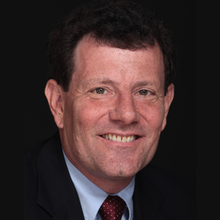克里斯淘夫,两次普利茨奖获得者
89-64是纽约时报驻京特派记者
他亲临现场,报道了所谓天安门事件前后的见闻和传言
有机会 可以看一下他当年发表在 纽约时报的原文,特别是 1989-6-13 等几日的。
当年读了他写的,天安门广场上无死亡人。别的地方有,他的估计是几百人(several hundreds) 或 三百人(three hundreds) ---- 笔者记不准了,以他的原文为据。
几百人死亡,与国内国外宣扬的 “至少10000人”,“2000人” “1000人” 形成鲜明的对照。
克里斯淘夫的数字 也是估计,是一个在北京生活了相当时间岁月,“有关系”的美国人的分析和估计,不是胡说,没有随大流,信口开河。可见其人学风和记者职业操守不凡。

Sheryl WuDunn 当年同时也是驻京记者
也写了有关天安门事件的报道
可以对照看看。
Nicholas D. Kristof
克里斯淘夫

Nicholas D. Kristof is a columnist for The New York Times, a two-time Pulitzer Prize winner, and former Beijing correspondent for the paper.
Yesterday The New York Times published what purported to be an account by a witness of troops attacking students on Tiananmen Square in Beijing before dawn on June 4. The article was published by the Hong Kong newspaper Wen Wei Po(文汇报), which said it was the account of an unidentified 20-year-old Chinese student, and was republished in The San Francisco Examiner. Nicholas D. Kristof, the Beijing correspondent of The Times, reports that the article does not correspond with accounts of other witnesses on important points.
This reporter and many other witnesses saw troops shoot and kill people before dawn on June 4. But these shootings occurred in a different place from that described in the Wen Wei Po article and in somewhat different circumstances.
The question of where the shootings occurred has significance because of the Government's claim that no one was shot on Tiananmen Square. State television has even shown film of students marching peacefully away from the square shortly after dawn as proof that they were not slaughtered. The disagreement is partly one about definition of the square.
The central scene in the article is of troops beating and machine-gunning unarmed students clustered around the Monument to the People's Heroes in the middle of Tiananmen Square. Several other witnesses, both Chinese and foreign, say this did not happen.
Troops fired on civilians in many parts of the city, but the shooting was concentrated along the Avenue of Eternal Peace, or Changan Avenue(长安街), which runs on the north side of the square. There was heavy shooting in the Muxidi (木樨地)district to the west of Tiananmen Square, and there were also many casualties along the Avenue of Eternal Peace to the immediate east of the square, as well as on streets to the south of the square.
Continue reading the main storyThis reporter saw troops fire on and kill people on the Avenue of Eternal Peace on the northern part of the square as well as some who were on a segment of the square just north of the avenue, near the Tiananmen Gate. But there is no firm indication that troops fired on the students occupying the monument in the middle of the square. On the Museum's Roof
There is also no evidence of machine-gun emplacements on the roof of the history museum that were reported in the Wen Wei Po article. This reporter was directly north of the museum and saw no machine guns there. Other reporters and witnesses in the vicinity also failed to see them.
The information in the Wen Wei Po article about students having 23 assault rifles and trying to return them to the army does correspond to a rumor that may have been correct. The rumor also reported, as does the article, that the army refused to take them back so that it could accuse the students of staging an armed rebellion.
But the article reports that the weapons were destroyed on the steps of the monument and this would have been difficult to do covertly. This reporter and many others were wandering about that day and some were constantly stationed on the monument. None of the correspondents there are known to have reported seeing any weapons destroyed.
The article reports that the lights on the square were extinguished at 4 A.M., and this is confirmed by three people who were on the square all night, two Chinese students and one French correspondent.
The central theme of the Wen Wei Po article was that troops subsequently beat and machine-gunned students in the area around the monument and that a line of armored vehicles cut off their retreat. But the witnesses say that armored vehicles did not surround the monument - they stayed at the north end of the square - and that troops did not attack students clustered around the monument. Several other foreign journalists were near the monument that night as well and none are known to have reported that students were attacked around the monument.
The witnesses give the same account. While troops were shooting in all areas around the square, they did not attack the students clustered around the monument. Instead, the students and a pop singer, Hou Dejian, were negotiating with the troops and decided to leave at dawn, between 5 A.M. and 6 A.M. The students all filed out together. Chinese television has shown scenes of the students leaving and of the apparently empty square as troops moved in as the students left. Few Could Have Remained
The witnesses do not definitely assert that nobody was killed in the center of the square. Some workers and students may have remained behind, but they would have numbered not more than in the dozens. Some protesters may also have been in the tents and been crushed by tanks, but they too would have been a relatively small number. The great majority left unhurt and were not shot at, the witnesses say.
The Wen Wei Po article also reported that the author had returned to the square in the early morning. But other witnesses say that the area was blocked off by thousands of soldiers and that there was still shooting going on in the area, so that it would have been difficult to go back.
The Wen Wei Po article catches the atmosphere and the terror but it has the clashes unfolding in the wrong place. On the Avenue of Eternal Peace, on the northern edge of the square, protesters were being killed by machine-gun fire, but not at the monument.
Continue reading the main story